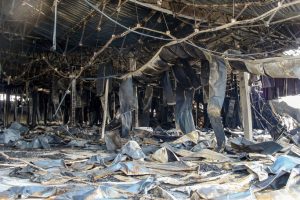Cannock warehouse destroyed by fire
A MASSIVE fire engulfed a 33,000m2 building in Cannock used for warehousing and distribution, sending plumes of smoke across the West Midlands.

The blaze, visible from 20 miles away in Birmingham, destroyed the logistics facility and will impact a number of businesses. The fire broke out on May 9th in a warehouse operated by Super Smart Services (SSS), a facility that is reported to handle over 70,000 parcels each day. The blaze required 10 fire crews, water carriers and aerial ladder platforms from the Staffordshire Fire and Rescue Service along with neighbouring fire and rescue services to contain it.
Business Sprinkler Alliance chair Iain Cox asks why the facility was not protected by a sprinkler system.
“The warehouse clearly did not have automatic fire sprinklers installed. Once again people are asking why not? The fire appears to be a repeat from six years ago of the massive Gardman fire, which destroyed a similarly sized unsprinklered warehouse six months after it opened. Both fires have led to common questions as to why a building of such scale did not have sprinklers. Clearly such a building at 33,000m2 and 15m clear storage height is not a common building. Therefore, one would expect it to fall outside of current guidance.
“The basic hazards of a warehouse remain the same, large stocks of combustible material held in perfect arrays for burning. The impact of free burning combustible storage is evident in the images from this fire. Unless caught early such high storage arrays generate fires that are beyond the intervention of the fire and rescue service. They lead to extensive damage and often burn until the entire fire load is consumed. Trying to stop the progress of the fire without the early intervention of water requires sacrificing parts or all of the building, unless a substantial fire partition or separation is engineered.”




